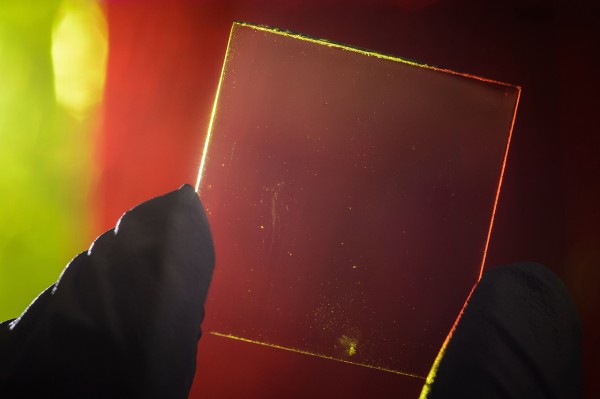 |
If solar cells are transparent, this means that glass windows in urban buildings can be made into solar panels. Even individual mobile phones and flat glass screens can absorb sunlight and extend life. Of course, smart watch devices can benefit from it. . It seems that all this will become a reality. The research team from Michigan State University developed a transparent solar concentrator. It can be seen from the figure that the human eye can clearly see through the panel device, and the device can obtain the electric energy from the light with invisible wavelength of human eyes. .
According to team leader Richard Lunt, they are not the first attempt to make a transparent solar panel, but this time this is a result of the best results, the panel is almost completely colorless and transparent. What makes this device unique is that the research team uses organic molecules in the panel to absorb energy from light invisible wavelengths in the sun. These light wavelength ranges are in the ultraviolet and near infrared range. Then a special wavelength of infrared light is emitted, which is led to the edge of the panel, where photovoltaic solar cells can be placed. “Because the material does not absorb any light in the visible spectrum, they are completely transparent to the human eye. But the downside is that the panel conversion efficiency is still less than 1% at present. The current team hopes to improve the conversion efficiency to 5% through improvement.
Although the current panel efficiency is not high, the application prospects are still very wide. In particular, buildings with large-area glass walls are the most suitable for the application of this technology, and the application of this panel on e-readers, tablet PCs and smart phones can provide additional power for the device. It is not yet clear when the solar panel technology will be commercialized, nor is it clear whether the panel cost of applying this technology is advantageous.

A Hose Clamp or Hose Clip is a device used to attach and seal a hose onto a fitting such as a barb or nipple. Many types are available, including American hose clamp, German hose clip, British hose clamp , Screw/band (Worm Gear) clamps, t-bolt clamp, Spring clamps, Wire clamps, Ear Clamp and so on.
Hose clamps are typically limited to moderate pressures, such as those found in automotive and home applications. At high pressures, especially with large hose sizes, the clamp would have to be unwieldy to be able to withstand the forces expanding it without allowing the hose to slide off the barb or a leak to form. For these high pressure applications, compression fittings, thick crimp fittings, or other designs are normally used.
Hose clamp Uses and applications
Hose clamps are frequently used for things other than their intended use, and are often used as a more permanent version of duct tape wherever a tightening band around something would be useful. The screw band type in particular is very strong, and is used for non-plumbing purposes far more than the other types. These clamps can be found doing everything from mounting signs to holding together emergency (or otherwise) home repairs.
Hose clamp Sealing and mechanical strength
One of the fundamental goals of most hose clamps is to ensure a tight seal between the hose and the barb, preventing the working fluid from escaping. To this goal, they are designed to provide even pressure on all sides, with no gaps. An example of this would be wire clamps. An obvious design would seem to be simply having a wire around the hose, one end attached to a nut, and the other end to the screw, and when tightened, pulling the ends of the wire towards each other. However, this will leave a gap where no pressure is applied (underneath the screw), and cause a leak. To combat this, the more complicated and weaker design of having the ends overlap and then be pushed apart from each other is used, as this ensures pressure around the entire circumference of the hose.
To ensure a good seal, the barb, hose nipple, or beaded tube must be smooth and free of nicks, scratches, or contamination. Stuck hoses should never be removed by slitting them, as this can leave a scratch on the fitting which will cause a leak.Hose Clamp
Hose Clamp,Stainless Steel Hose Clamps,Hose Clip,Pipe Clamps
SHIJIAZHUANG TOPA TRADING CO., LTD. , http://www.topahydraulic.com